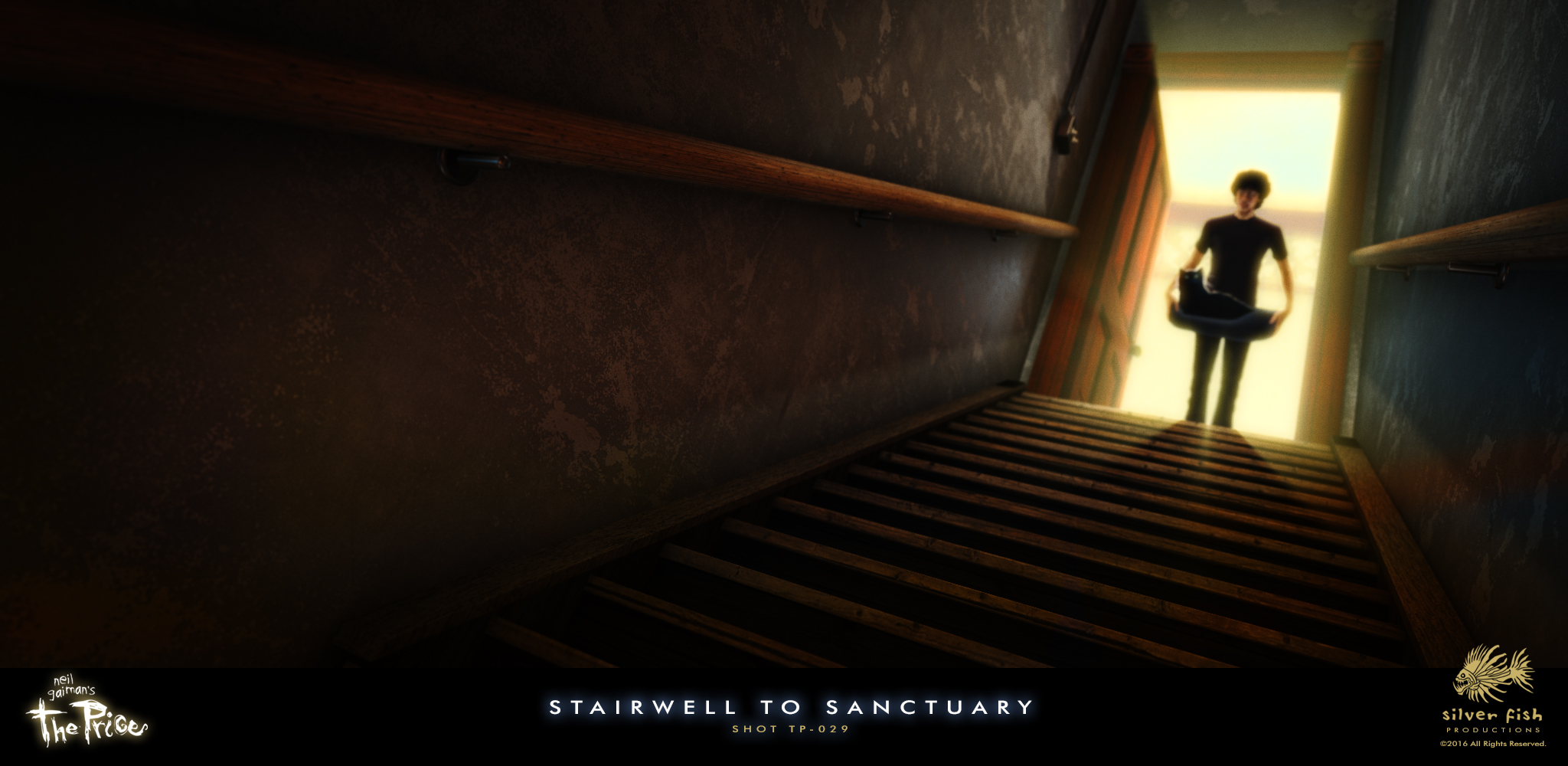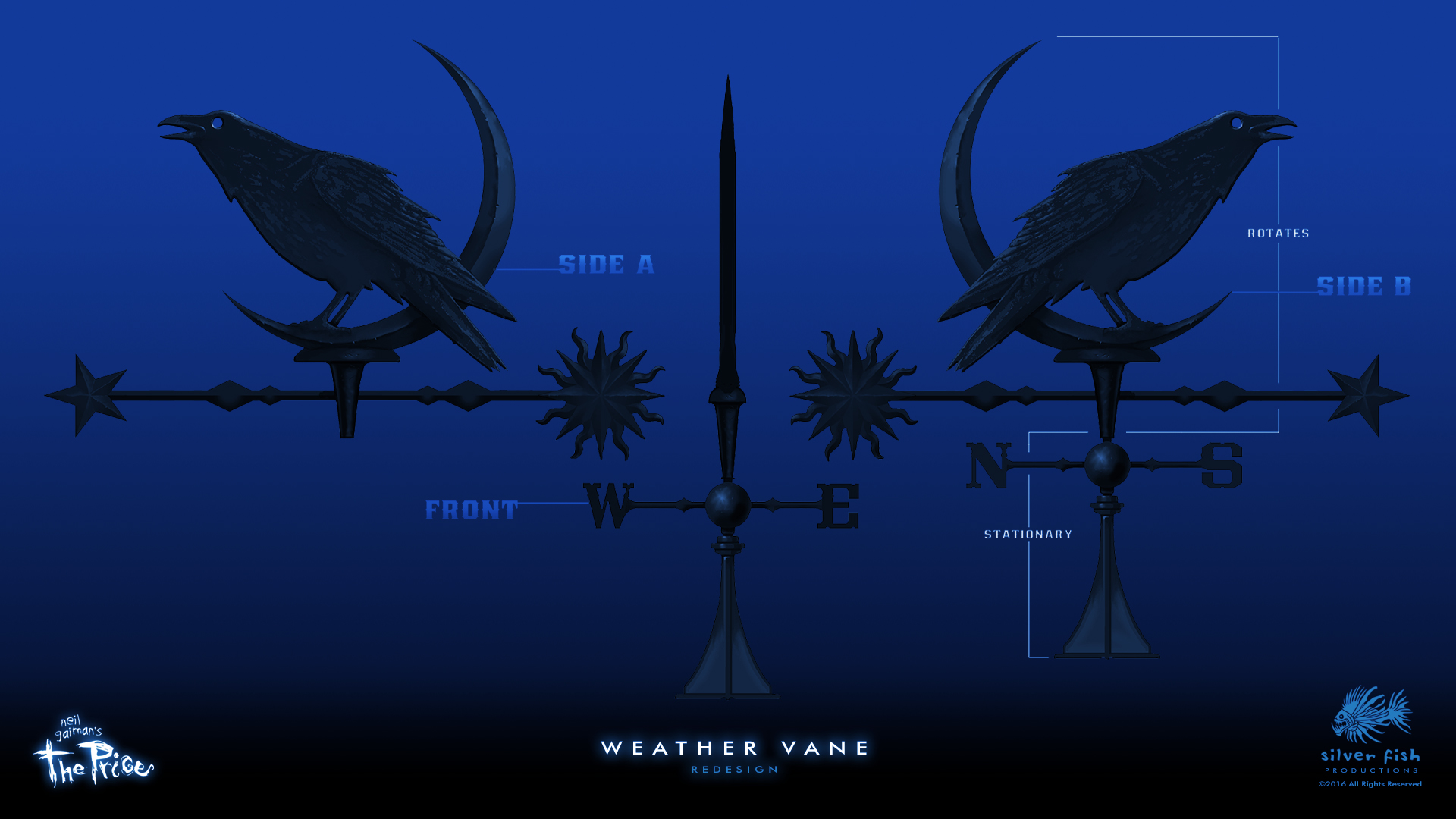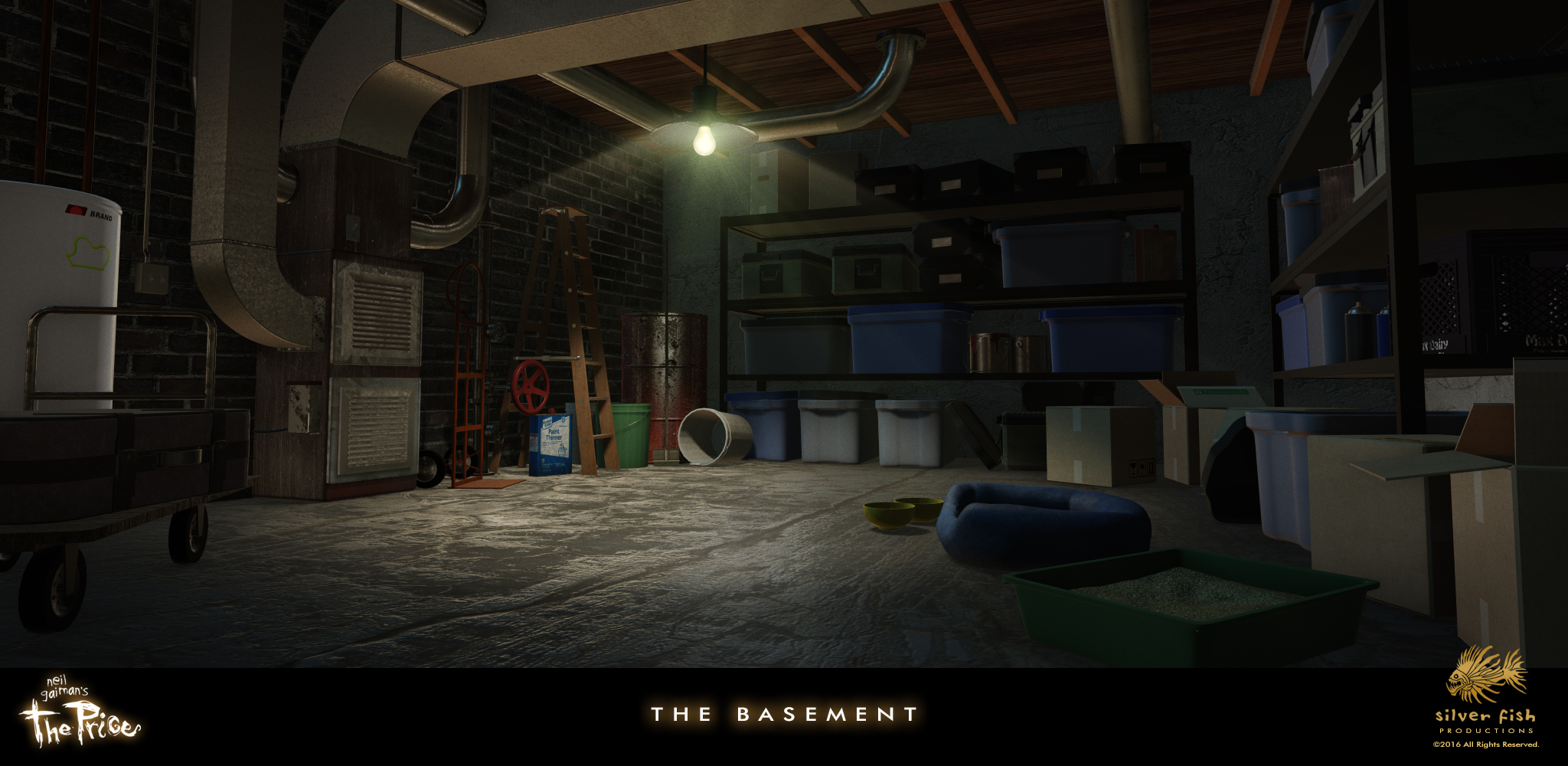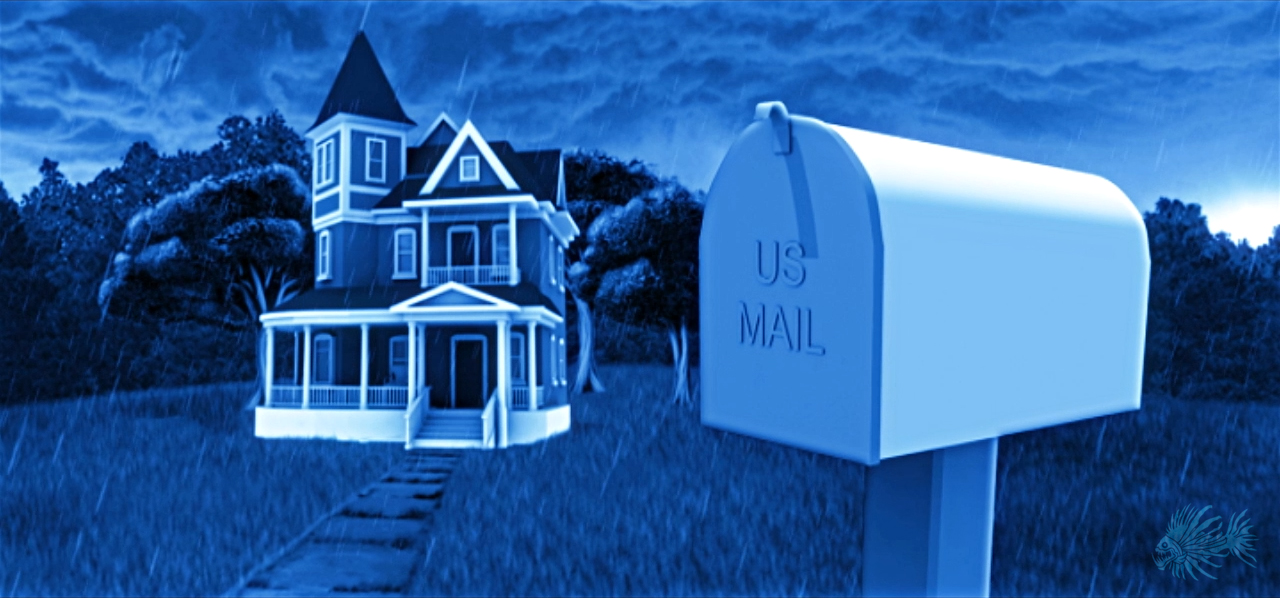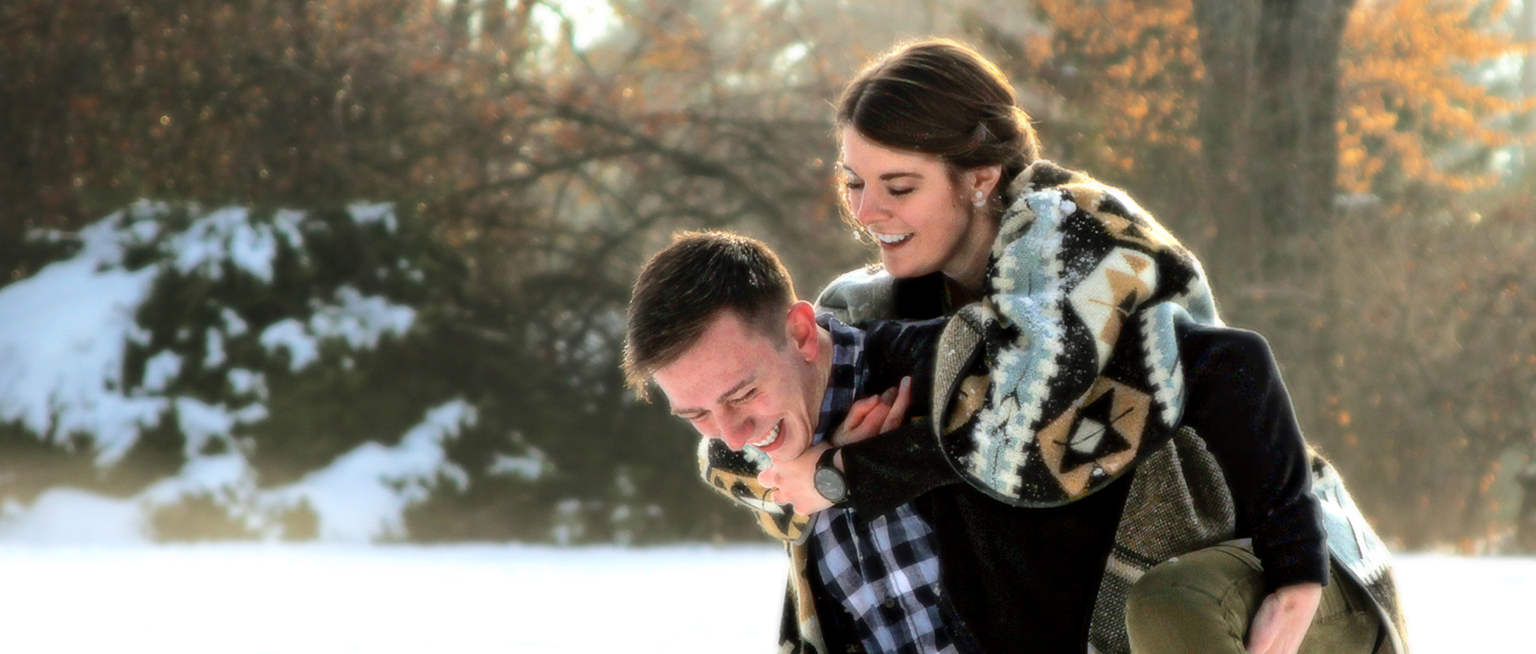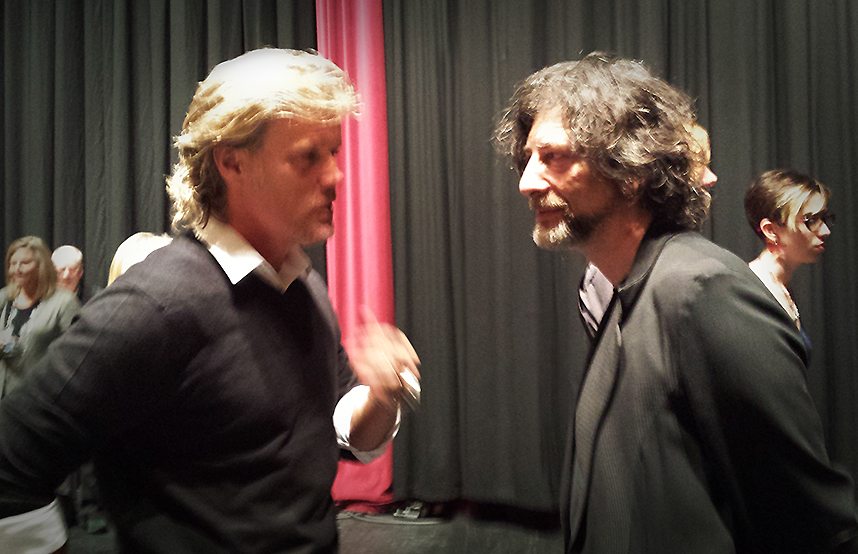Here’s a quick shot I took of what’s currently on my screen: The Black Cat’s very own “stunt” double (hairless at the moment). Used in medium to long shots, this model can be posed and animated in real time. (For those emotive close-up shots, a “hero” version of TBC is rendered in a different program.) I’ll show a demo later on of how this guy works and has solved a specific set of problems for me on The Price. More soon!
Grade School Graveyard
I wanted to add a quick update concerning the image I posted last time of the basement stairwell. Most of the comments I received were very complimentary (for which I gratefully thank you), but a few also included an interesting observation: that the narrower dimensions of the stairs in the original animatic image added more to the sense of tension and unease I was trying to evoke than the revised set. As an artist, I genuinely value constructive critiques of my work; after looking at the same thing for an extended period, it is always a challenge to see with fresh eyes. Although I don’t feel obligated to agree with every proffered observation/opinion, I did in this case, and offer a revised version that I feel works much better. Thanks everyone! 
Since one good turn deserves another, I wanted to share something fun that you might get a kick out of. My 11 year-old son had an assignment in his 6th grade class to create a video book “trailer” earlier this year, and guess what book his group chose? None other than Mr. Gaiman’s masterwork, The Graveyard Book! And while the kids themselves wrote the script, chose which scenes to include, played all the roles and decided how it was to be put together, they asked me to help with the “special effects” and other post production duties as it was shot almost entirely using greenscreen. The finished video was shown at a local theater as part of a 6th grade “Film Festival” (with the kids all being chauffeured by limo to walk the red carpet, et al), and The Graveyard Book won 8 awards! (Some parents grumbled about my participation, but it really wasn’t a true competition, and the teacher in charge welcomed the opportunity for me to show the students some advanced techniques.) The kids had a blast (and so did I), so we hope you’ll enjoy it as well:
Composition and Contrast
Whether you are drawing a picture, staging a scene in a play, or taking a photograph, the way you choose to present the elements of your creation to an audience has a huge impact on how they will receive the message you are endeavoring to send.
As I was starting to put together storyboard frames for the animatic, one of the first images that formed clearly was this one:
There are times when I struggle to find an interesting way to visualize a scene, but this one leapt fully-formed into my mind. It made me feel everything I was hoping to convey: trepidation, wariness, anxiety and a bit of mystery as well. Although it may just be a basement stairwell, at this point in the story the audience needs to feel like there is definitely something askew with the visit of this seemingly innocuous black cat. I didn’t try to over-think things when putting it together, but the lower, canted angle, strong contrast, and the off-center placement of the doorway at the top of the stairs all combined to create the tone I wanted. It remains one of my favorite shots, so when it came time to build the actual scene, I kept the composition intact.
I hope you are enjoying these images and insights as much as I enjoy sharing them!
Oh, one last thing: is anyone planning on attending the San Diego Comic Con in July? Just asking…
A Change in the Weather
I don’t know how it may be for you, but where we live, the weather has been doing its springtime-schizophrenic-thing with great abandon this year! (I went camping with my son’s scout troop 2 weeks ago and froze all night long; now I can’t sleep in my own bed without the overhead fan spinning away.)
Thinking on these thermal vacillations suggested an interesting detail to share with you: during my oft-referred to visit at Castle Gaiman, a roofing company happened to be effecting some repairs with a specialized truck that featured a platform attached to a crane/boom arm that could extend all the way to the top of the house (I believe they called it a “cherry picker”). With Neil’s kind permission, I had the operator take me up so I could shoot references photographs from a unique vantage point. I’m not gonna lie — it was a blast to ride in, and also an unexpected treat to experience high-altitude views of the house and property.
Photo by: Cat Mihos
One of the details I was excited to see in person was the distinctive weather-vane that adorns the tower at the front of the house.
Although interesting in its own right, I wasn’t as keen about the design as I had anticipated. After reviewing the photos later, I still felt a bit disenchanted, and decided my Castle Gaiman would need to have something a little more…spooky.
So, I approached my friend, the talented designer-illustrator Dave Laub, and asked if he could take the basic idea and give it his customary Laub-ification treatment; here’s what he came up with:
Pretty cool, right?  Needless to say, I was thrilled, so the design was given to master-sculptor Ryan Peterson, who translated Dave’s 2D concept into an actual 3D model. (For a more detailed explanation of this process and some examples of how it works, you can watch — or perhaps re-watch — this videoblog on Digital Sculpture & Design.)
Needless to say, I was thrilled, so the design was given to master-sculptor Ryan Peterson, who translated Dave’s 2D concept into an actual 3D model. (For a more detailed explanation of this process and some examples of how it works, you can watch — or perhaps re-watch — this videoblog on Digital Sculpture & Design.)
You may be asking at this point: so, why all the fuss? The next time you are watching a movie, you might notice that alongside the shots you would normally expect to see, like close-ups when people are talking to each other, or establishing shots of locations that let you know where the next scenes are going to take place, etc., there are other, less obvious elements used to help move the story along. One of these cinematic devices is called a transition, which does exactly what it sounds like: helps the viewer make a transition from one place (or idea, or emotion) to another without getting confused feeling jarred out of the moment. I wanted to feature the weather-vane in a close up to serve as a transition point in the film, both visually and tonally; take a look:
 It’s at this juncture in the story where bad things begin to occur, and which seem to be somehow connected to the Black Cat. I’m hopeful that this imagery won’t feel too “on-the-nose” to viewers, but will impart a subtle sense of foreboding.
It’s at this juncture in the story where bad things begin to occur, and which seem to be somehow connected to the Black Cat. I’m hopeful that this imagery won’t feel too “on-the-nose” to viewers, but will impart a subtle sense of foreboding.
Well that’s all for now; have a tremendous week! (And keep an eye out for those sudden storms…)
The Basement
For this week’s post (yes, I am going to post something every week from here on out — even if it’s just a quick, frustrated blurb or scribbled drawing of some sort), I thought I’d share this image of one of the featured locations in the film: the basement.
This set was built using some of that new “tech” I was referring to in the last post, which allows me to move objects, lights and camera around in real-time, helping to dial-in an amplified, illustrative feel for The Price. No more waiting (like in the “Old Days”) for minutes/hours between adjustments while the computer crunches away — it really is such a huge artistic advantage! To compare, here is an image of the quick 3D set I cobbled together for the animatic:
When developing the animatic, I realized this was one of the sets I couldn’t just “fake” with a simple image for the background, as I had to generate multiple shots from very different angles. Luckily, these renders were very simple, didn’t have any real textures or colors to worry about getting right (as the images were eventually turned monochromatic), and were only meant to get the general idea across. If you look carefully between the two versions, you can see that I’ve re-purposed some of the same models (although they have been upgraded significantly).
One last thing you may find interesting: to keep from going crazy, I sometimes amuse myself by adding little references to various friends and family members into the background of shots, like the label for this paint thinner can:
(“Kodus” is a nick-name for one of my sons…and yes, the rest of my kids are watching very closely to make sure they don’t get slighted.)
At any rate, I hope you enjoyed this quick peek; have a great week!
PS: For the record, Neil’s basement looks nothing like this. It’s got a marvelous library, tons of comics, and is both inviting and comfortable in every way; that wouldn’t really work too well for the movie — I want my basement scary and mysterious! 
Photo by: Kyle Cassidy
A Lonely Road
So, the bad news is that once again it has been several months since I posted an update here, and for that I am genuinely sorry. The good news is, I have a new image to share, along with a fairly extensive update… so let’s get started:
I chose this shot because it’s a good example of how an initial idea can change and develop over time. In the original animatic, this scene was very different:
I didn’t have much of the geography around the house worked-out beyond some grass, a bunch of trees in the distance and a road. In fact, if you look too long at this frame, you’ll find all sorts of things that don’t make any sense — but the point of the shot was, “Look! There’s a mailbox!” and maybe a little bit of, “Oh yeah, it’s rainy and gloomy too,” thrown-in for good measure.
I was never happy with the original shot, but didn’t have any clear ideas on how to make it better until my dream-like visit to Castle Gaiman. Turning off a dark country road to move slowly up the gravel driveway toward this eclectic home which had figured so prominently in my imagination over the past few years was beyond thrilling, and surprising as well. The trees lining either side were larger and more mature than I had pictured, and the driveway itself far longer.
These impressions recurred during the next two days as I walked around the property taking reference photographs. In particular, the view from either end of that driveway, with those tall trunks framing its length was quite striking. All of these perceptions were added to the jumbled pile of ideas rolling around inside my head. They eventually emerged as an idea for adding a wider establishing shot at this point in the film using a similar composition (along with fog for separating the layers of the image and increasing visual interest).
In terms of sharpening the cinematic language of The Price, intentionally cutting from such a wide shot down to a close-up of the letter received from the author’s distraught daughter is a bit jarring, and helps add to the building unease of the sequence.
—
Now, I also wanted to elaborate on the current state of the film and where things are headed.
I had an opportunity not long ago of attempting to do exactly this with my youngest brother, Jeff. Living almost 1100 miles away, I don’t often get to visit with my family; unfortunately, the reason this time was neither fun nor recreational (I’ll get to that a little later).
Jeff said he wasn’t exactly sure he understood what was happening with The Price other than production was taking far longer than anticipated, that I was stressed and agitated over its slower progress, and there seemingly wasn’t much to show for all of that work so far…
So I began talking, and about an hour later, he seemed satisfied — to the point when he stated enthusiastically that I should write something similar here in hopes that it might be helpful to those of you who have been waiting so patiently. So…here goes:
At the beginning of my Kickstarter campaign for this project, I had determined not to attempt full-blown animation as the cost, time, and manpower wouldn’t justify the production of a short film with no real chance of making back any investment. Besides, the style on display in the animatic seemed to be intriguing to viewers — having images that blended between poses like a moving graphic novel. That was an approach I could handle mostly on my own, and for a far more reasonable budget.
After years of fruitless searching for a way to fund The Price, Kickstarter suddenly appeared on the horizon, and I knew how this film could finally happen. 33 days and 2001 backers later, it was on!
Creation is a process of discovery, and you need to allow for some false-starts and dead ends as you make your way along an unknown and lonely road; sometimes, the way to find the right path is to go down all of the wrong ones first. As Thomas Edison famously said, “I have not failed. I’ve just found 10,000 ways that won’t work.”
To wit: the character models were designed and built with the intent that they be posed and rendered as single images rather than a series of animated frames. These digital sculptures, created by Ryan K. Peterson, were phenomenally crafted, but proved difficult to translate from the sculpting software into another 3D program that would create the hair/fur needed, allow each model to be moved into the requisite poses, and then rendered with the correct lighting and materials (for example, having skin with translucent properties). We tried multiple methods and insanely over-complicated combinations that all yielded disappointing and compromised results. Time was ticking away, and every road seemed to lead nowhere.
The sets and environments had their own issues as well. The model of the house was large and unwieldy, and getting it to render was also a royal pain! Using a traditional rendering pipeline meant having to wait for long periods of time (even hours, when you only have one machine working on it) before you can see if you placed your lights properly, had everything aligned in the shot correctly, or if the overall look was somewhere even close to what you had been aiming for. It was like moving things around in a darkened room, then having to wait for the lights to finally come on in order to see what you had done — argh!!!
In a full animation studio, there are many groups of skilled artists and technicians that focus on specific problems and details like these (not to mention the vast rendering “farms” created from hundreds of dedicated CPUs to crunch all of that data). I had just a few guys contracting with me to build/create the things that I couldn’t, and then I was to combine all of these custom pieces together myself. I began to realize that despite my initial, more modest ambitions, what I actually wanted now was to try and create a full-blown professional-grade product, only it had to be made by hand on a very limited budget.
Regardless, I was determined to fight my way through these obstacles, even as they continued to pile-up in relentless fashion.
Then, as time continued relentlessly by…something changed.
Technology.
Suddenly, the sculpting program we used introduced newly-developed tools, and partnered with a company whose ground-breaking renderer could import the files directly and render them quickly, right in front of your eyes. You could tell within seconds if the lighting design worked, and the model materials looked like they were supposed to, with hardly any major tweaking — it was mind-blowing!
Then, a whole new world of possibilities opened up with a program called Element 3D, created by Andrew Kramer and Video Copilot. This special plugin allowed 3D models to be opened in Adobe After Effects, the program I use for compositing all of my shots, and with which I feel extremely comfortable. What all of that means is I could now bring my house model into After Effects and light it, position and modify it all in real time! I had immediate results that would respond instantly as I changed parameters and settings, using the same kind of GPU magic that today’s highly sophisticated videogames also use. Having instant feedback so I could dial-in the look of these models was now a reality — and I could do it myself on my single (though admittedly, crazy-powerful) workstation. Light bulbs (Edison again) were literally popping-on in my mind like machine-gun fire!
And with these new capabilities came a slew of tantalizing possibilities as well. For example: do I really have to keep all of these images static? Wouldn’t it be so much more immersive to start the film by moving the camera slowly toward the house, past thousands of blades of 3D grass and right up to that tree trunk with those strange markings on it that reveals the film’s title? (If you haven’t already seen this shot, click here.)
Can you see where all of this is going? Imagine, after spending years of tinkering, trying to put a car together in your spare time with a bunch of custom-made components, you realize you now have the ability to build something more sophisticated, powerful and even more beautiful…but that means taking it all apart and then putting it back together in a new and different way. That’s the best metaphor I can think of to describe where things are. None of the parts that have been worked on so diligently have been cast aside or wasted, just used in a better, more advanced fashion.
I’ve stated this before, but it bears repeating here: even more than money, my Kickstarter backers have afforded me the rarefied opportunity to create something at my very best, A+ level. Because there is no paying client waving a glaring deadline in my face, I can listen to that aesthetic-driven voice in my head that sees a better way of putting things together. Trying to explain why an artist should pay heed to that voice is difficult — how can you quantify inspiration or justify a creative instinct?
Ultimately, the process of creation really is a lonely road, and always traveled for the very first time. It’s never easy to attempt an explanation as to why something looks “off” to me, or how I know when something else feels “right.” It’s like being asked where ideas come from — how can you answer that? All I know is that you need to start the journey with faith in that inner sensibility, then be willing to head down the unknown path alone, wondering at what you’ll find…
Of course, this process takes time. We all have lives to live, and life frequently requires things of us that we may not have accounted for.
Now back to why I was visiting my brother Jeff: he called early Sunday morning on the last day of January to tell me that our father had suffered a heart attack; less than an hour later, he called again to say that he was gone.
Photo: Shain Walker
(I was going to share some things with you here about my Dad, but have decided to save those thoughts and precious memories for a later post.)
I stayed with my Mum for awhile after the funeral. She has a wonderfully resilient outlook, but now bears the burden of living alone and managing the small farm that our family enjoyed so much growing up. Life has drastically altered the rules for her, and yet she is finding her way along this new path.
That’s what we all do. My wife always refers to Dory’s refrain in Finding Nemo as our family motto: Just Keep Swimming. Sure, that sounds especially fitting when you consider that our last name is Salmon, but there is a profound truth to be found as well. You just keep moving forward, no matter what comes your way.
And often, those life events are joyful and glorious: last month, my daughter Shain (who took the marvelous picture above) was married to her best friend (a really great guy), the first of our children to do so.
Above all, family remains the highest priority, despite schedules brimming with responsibilities and activities that demand our time and attention.
Having the chance to make this film in the way that I want to is a great privilege, one I feel immense gratitude for. The constant support and encouragement from the vast majority of you, including Mr. Gaiman, helps more than you realize, especially on those days when the obstacles loom large and discouragement tries to worm its insidious way into my heart.
But I’ll never give up. It’s simply not an option.
Neil said that I fell in love with The Price, and that really is the best way to put it. Of course I am anxious to have it finished — and I will always maintain that no one wants to see this movie more than I do! I constantly daydream of being invited to some sort of Gaiman-centric event one day in the near future and being able to show it to all of you, getting to feel your response in person. This project has been part of who I am as an artist for so long now, I will always feel a deep connection to this moving and thoughtful story of when The Black Cat came to stay.
So don’t give up hope; I may still be walking down that lonely road, but know I will be returning soon to share what I’ve found along the way.
The Study
In an effort to post more frequently, I’ll spare you the lengthy epistle this time around, and share an image instead: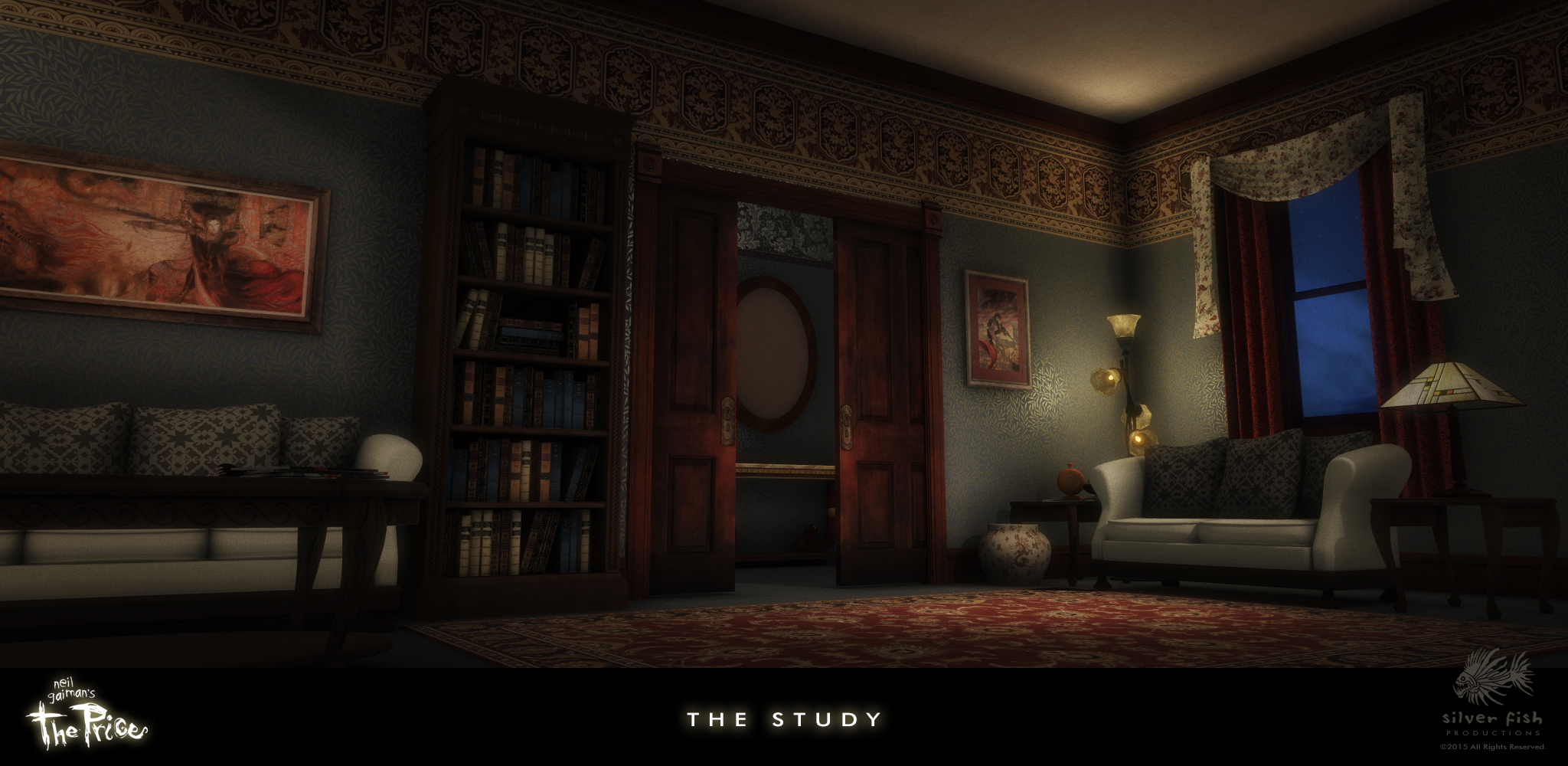 Many details here were inspired by my visit to Castle Gaiman, but as with the layout of the other interior sets, I have taken many artistic liberties in order to capture the angle, composition and mood I’m trying to achieve. And for any of you CG-geeks out there, this entire set is built and rendered in real time (courtesy of Video Copilot’s Element 3D), all inside of After Effects — pretty cool, right? Hope you enjoy the sneak-peek — more to come!
Many details here were inspired by my visit to Castle Gaiman, but as with the layout of the other interior sets, I have taken many artistic liberties in order to capture the angle, composition and mood I’m trying to achieve. And for any of you CG-geeks out there, this entire set is built and rendered in real time (courtesy of Video Copilot’s Element 3D), all inside of After Effects — pretty cool, right? Hope you enjoy the sneak-peek — more to come!
Gentle Reassurances
It’s been another long stretch between updates, and I have been meaning to share the following experience with you for some time:
In April, I discovered to my great delight that Mr. Neil Gaiman would be visiting Park City on the book tour for his latest short story collection, Trigger Warning. After a call to my producer Cat Mihos to see if she might be able to help procure tickets (and who, as always, delivered in spades), my wife Glynis and I headed up the canyon on a very pleasant Saturday afternoon, albeit with some nervous trepidation. While hers was more general in nature (like not knowing what to wear mixed with being excited to meet him), I had a more specific focus: I have had several “stress dreams” over the past few years where I am visiting Neil again (somewhere), and he refuses to talk to me or even acknowledge my presence! I know (from Cat) that he occasionally gets asked about The Price and its progress, and I never want him to regret telling CNN about the project and the Kickstarter campaign,
“For an author, it’s fun. Instead of selling the rights to my story, to actually kick in a few hundred dollars — but I don’t think I could do that if I didn’t trust Christopher Salmon to make a great little film.”
Given how long this production has taken, you can see why I was a little concerned at what he might say, face-to-face.
Well, I needn’t have worried. Once we arrived and gave our names to a very helpful staff member of the Park City Institute venue, we were escorted backstage to join a group of about 40 other people, who were milling about and eating snacks while awaiting their turn for an audience with Mr. Gaiman. Glynis and I took our place in the queue and watched him take his time greeting fans and chatting amiably with each one (I’ve noticed with amazement at how patient and genuine he is with people in general). After listening for a moment, my wife leaned over and whispered, “Wow, that voice…” She has become well-acquainted with its tone, timber and cadence, having heard his recorded narration of The Price on countless occasions (mostly as it issues forth with regularity from my basement cave/studio), but it is exponentially more mesmerizing in person. I kept stealing glances at him and noticed he looked a little different since I visited Castle Gaiman 4 years ago, most notably with the addition of a beard. At one point, he actually called out “Hello Christopher,” while finishing-up with his current guest. Then it was our turn.
I said hello, shook his hand and hugged him, and introduced my wife. She has a natural grace with people no matter the circumstance, and stepped over to him, saying easily, “I have to give you a hug as well!” Then while still hugging him, she said very quietly, “Thank-you for believing…” As her voice started to break, the moment became something tender and heart-felt. He hugged her back with genuine affection, and the last vestiges of my anxiety melted away completely.
We had a wonderful conversation (while several of the bewildered guests backstage looked on, no doubt wondering why they didn’t get a hug); I mentioned his beard (“I do some teaching at Bard’s [a College in NY] and so I needed to actually look like a professor for the students to take me seriously.”), congratulated him and wife Amanda Palmer, who are expecting a baby in September (“I’m absolutely terrified!”), and that led us to talking about families and sibling age differences. Then, in a more somber tone, he said he knew that our family had experienced some very difficult events recently, to which Glynis replied, “Yes we have; but everyone has their own trials to go through, don’t they?” Neil paused and said thoughtfully, “It’s true, we all do.” Again, her response was perfect and seemed to acknowledge his sympathies without making things feel too heavy.
He then told me how much he has enjoyed everything I’ve posted about The Price, and surprised me by saying, “When you are finished with the film, we should get together and re-record my narration. I was very, very tired when I recorded it the last time, and once we have a copy in the studio and can play it back, I can read to match the feel of the film.” I was stunned, because that is precisely how I was feeling about the recording we made in LA at Rob King’s Green Street Studios — but I certainly wasn’t about to complain, or try and impose upon his good nature to do it all again! He said he watched the teaser trailer and remarked that the visuals were so good, he wanted to bring the audio up to the same level (I think my grin was so wide at that moment it almost cracked my head in half). I was deeply impressed that he recognized the discrepancy and then kindly suggested we do it again, sparing me the difficulty of having to ask, all the while reassuring me that my sensibilities were on track. I promised him of my resolve to never give up, and had the overwhelming sense that he was very pleased with what I was doing and confident in what The Price will become. We took some pictures, said our goodbyes, then Glynis and I took our seats and thoroughly enjoyed the next 2 hours as he enchanted and delighted the sold-out Eccles Center audience. (You can listen to a recording of the event here.)
Later there was an after-party held in a local gallery where we had a chance to meet other NG admirers and talked with two different couples who recognized me and were following the progress of my little film (one was a Kickstarter backer, the other had attended a presentation I recently gave at the Life, the Universe and Everything Symposium). It was humbling and extremely gratifying to feel their enthusiasm for the project. Despite the occasional negative comments I get, having the opportunity to interact with people standing right there in front of me who are as excited as I am to see the finished film was uplifting and hugely inspiring.
I drove home that night wondering at how — just when your reserves feel as though they are about to run dry — these incredible experiences seem to come along in the proverbial “nick-of-time.” Personally, I don’t believe them to be coincidences. Getting those gentle reassurances was exactly what I needed… and now I pass them along to you.
Devil In The Details
One of the (many) difficult aspects of creating filmic images from a computer is being able to light things the way you would like. In the real world, you can use actual lights and place them relative to your subject to achieve the look and feel that good lighting can provide. Since the “actors” and objects in my film don’t exist except as zeros and ones somewhere on multiple hard drives, this process can be much more difficult & tedious.
Because the “rendering” of a character image (think of it as the way a computer creates or “draws” something) can take a long, long time, there are real disadvantages in creating the lighting wholly within your 3D program; as you might imagine, waiting for 3 hours to see how an image actually looks with the lighting you designed, only to discover it isn’t at all the look you were trying for…that process gets frustrating rather quickly and stifles creativity. You can literally go back and forth for days, making adjustments and tweaking things in the endless pursuit of matching what you see in your mind’s eye. (Makes me feel anxious just describing it!)
One of the great techniques I’ve discovered from my After Effects Guru Andrew Kramer (at Video Copilot) is being able to “re-light” an image after it has already been through the lengthy rendering process! The key is to create what is known as a “normal” map of your 3D model along with the regular image. In CGI parlance, a “normal” is a piece of information that tells the computer which direction in 3D space an object is pointed, so that lighting can be properly calculated. It is kind of a strange concept when you first think about it, but makes sense when you realize that it is all part of the telling the computer exactly what you want it to do. Here is an example:
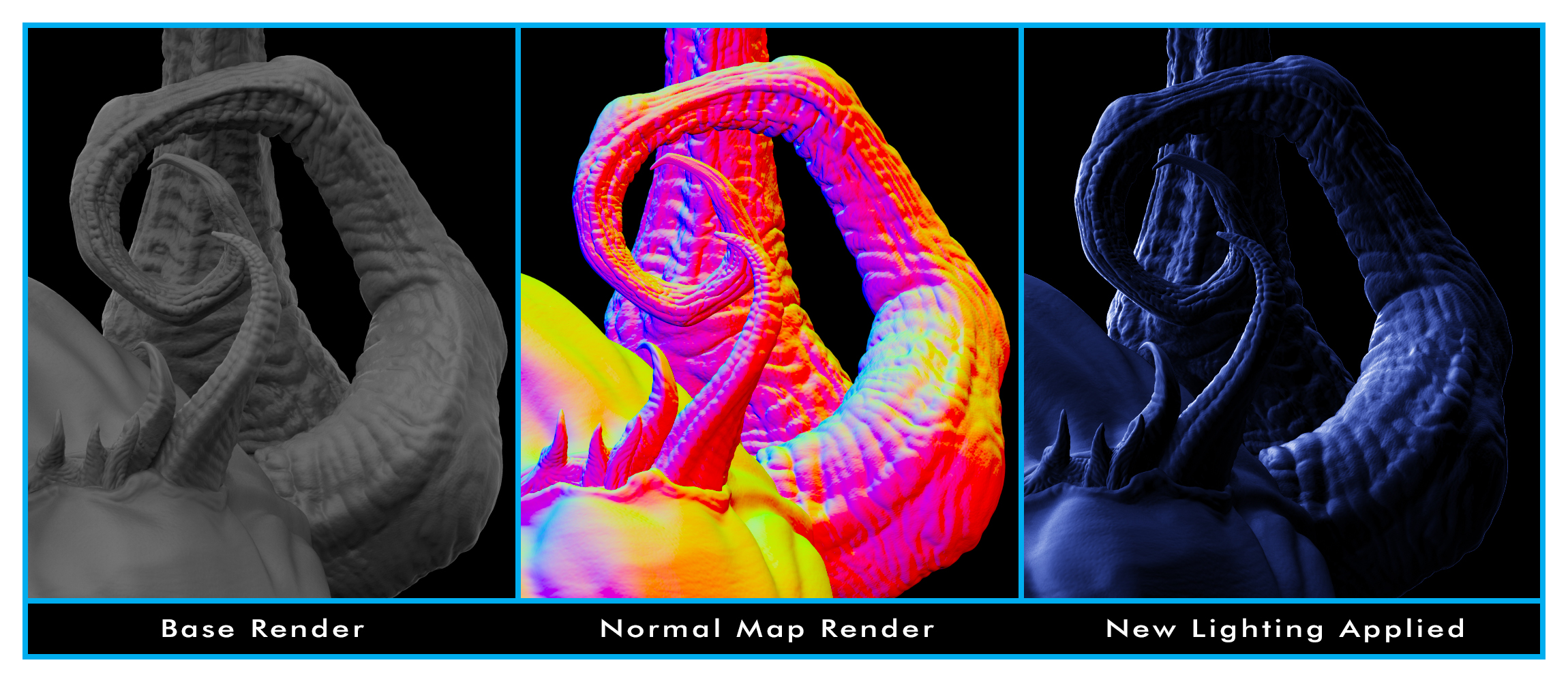 On the left is part of a rendering with pretty flat lighting, where I wasn’t concerned yet with trying to create the stylized, moody lighting that the final scene would have. The center image is the normal map; although it looks like something out of a 70’s-era DoodleArt poster, the intense and varied colorations on the image “map” out which way each individual surface of the model is facing. The image on the right was produced by combing both of the other images in Adobe After Effects (the compositing/special effects/animation program I am using to generate all of the shots for The Price) and introducing new 3D lights to create the look I want.
On the left is part of a rendering with pretty flat lighting, where I wasn’t concerned yet with trying to create the stylized, moody lighting that the final scene would have. The center image is the normal map; although it looks like something out of a 70’s-era DoodleArt poster, the intense and varied colorations on the image “map” out which way each individual surface of the model is facing. The image on the right was produced by combing both of the other images in Adobe After Effects (the compositing/special effects/animation program I am using to generate all of the shots for The Price) and introducing new 3D lights to create the look I want.
This process is enormously freeing, as I can rework it at any time to conform to new ideas or scene configurations without having to spend hours rendering just to see if an inspired thought had merit or not. Pretty neat, huh? 
Here is an image from the same rendering I thought might be helpful for keeping everyone in the proper ‘spirit’ this week. Enjoy, and have a safe & spooky Halloween!








